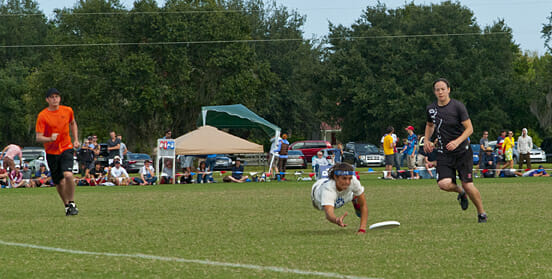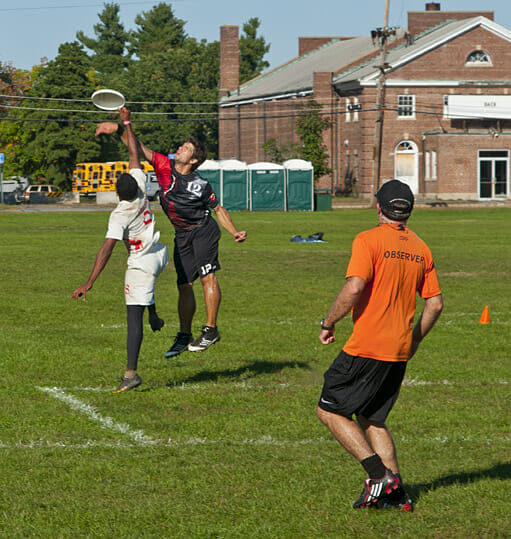September 18, 2012 by Adam Ford in News, Other with 3 comments
 This is the fourth article in our series, Team Orange: A Comprehensive Guide to the USA Ultimate Observer Program. Includes contributions from Will Deaver and Vic Kahmi.
This is the fourth article in our series, Team Orange: A Comprehensive Guide to the USA Ultimate Observer Program. Includes contributions from Will Deaver and Vic Kahmi.
As a Head Observer, there have been times when I’ve had to shuffle Observers around so that certain Observers are not observing certain games, due to the fact that they’ve played on one of the teams involved. And I’ve heard complaints from players that they think that an Observer who used to play for the team that they were playing was biased for that team.
But I honestly feel that any Observer can fairly observe any game, even if it’s a game involving their own team. Why? When I am asked to make a ruling, I see hands, arms, legs, dark jerseys and light jerseys. I am concentrating on what is happening with the players and the disc at that moment. Sometimes I don’t even remember which team is which, just which player is where and what just happened. I see two players and I make a ruling for one of them. Who the players are is inconsequential to what is going on.
What Game Are You Watching?
 What does each Observer have to watch? The trailing Observer has to be close enough to the thrower to hear the stall count but not so close as to interfere with dump cuts (yes, players have thrown dump passes to Observers). In the beginning of a game when I’m trailing the play, I watch the “whole picture,” keeping an eye on body positioning, closeness of the mark, contact, and foot placement. As the game progresses, certain calls may become more frequent. If there are a lot of travel calls, I begin to focus more on the feet. If the marking is particularly aggressive, I watch that. Often there are certain players who always travel or who call traveling a lot. I learn who to watch for on the field so that I can make accurate calls if asked.
What does each Observer have to watch? The trailing Observer has to be close enough to the thrower to hear the stall count but not so close as to interfere with dump cuts (yes, players have thrown dump passes to Observers). In the beginning of a game when I’m trailing the play, I watch the “whole picture,” keeping an eye on body positioning, closeness of the mark, contact, and foot placement. As the game progresses, certain calls may become more frequent. If there are a lot of travel calls, I begin to focus more on the feet. If the marking is particularly aggressive, I watch that. Often there are certain players who always travel or who call traveling a lot. I learn who to watch for on the field so that I can make accurate calls if asked.
Of course, if you’re watching the feet, you’re not watching the hands as closely. I have had to make “I didn’t see it” rulings a few times because I was concentrating on one area and a call is made in another. But overall, the trailing Observer is predominantly watching two players, the thrower and marker.
This concentration on the play can have its downsides. I’m watching each play, each player interaction, as it’s happening. There have been a few times when a travel or pick call was made and I didn’t hear it, whether because it wasn’t echoed or the crowd noise was too high. Play eventually stops and I’m asked for a ruling. Honestly, that was two passes ago, and while I may have seen it at the time, I’ve completely forgotten.
The downfield Observer has it a bit tougher. As well as having to make the occasional full-on sprint to the end zone to see a play, the downfield Observer has to watch six cutters and their defenders and be constantly aware if a defender is legitimately close enough to call a pick or not. Also there could be any number of people involved in a disputed foul, which makes separating out the action that much more difficult. Plus, a downfield Observer has to stay off to the side to stay out of the way of the game.
One of the hard parts of being a downfield Observer is not paying attention to the thrower, especially when the action is close to the end zone. With less field to work with (especially now that end zones have been shortened from 25 yards down to 20), there’s a lot more opportunities for picks, and while it’s tempting to watch where the disc is (and you have to at least be aware of where it is), you have to concentrate on the cutters and the goal line.
Finally, Observers watch for offsides, keep track of time, and try to keep the sidelines relatively clear, which can get difficult in tournaments where fields are five yards apart or less.
Some notes about pulls. What are the rules? Receiving team players must have one foot on the goal line and not change their positions relative to each other until the pull is released. Yes, that means that your other foot can be in front of the goal line if you want. You just have to have one foot on the line. Pulling team players cannot have either foot cross the plane of the goal line before the disc is released.
When I signal to a receiving team that they have 20 seconds to signal readiness, sometimes a team will wait until they have 10 or 5 seconds before signaling, others will signal right away. If a receiving team signals that they’re ready when they have 20 seconds left, the pulling team still has 20 seconds, plus the 20 seconds allowed to them after the receiving team is ready. The between-point length is always 90 seconds.
Discipline
I was observing a final game in a tournament and a player on offense cut across the front of the end zone, caught the disc for a score, and in the process was hit to the ground by an aggressive layout bid from behind by his defender. The receiver pulled himself up quickly, turned, and shoved his defender, throwing some angry words at him. Both teams immediately stepped in and defused the tension, and the two players involved walked off to their respective sidelines.
I conferred with the other Observer working the game and we announced our rulings to the two captains. The team on defense would receive a Team Misconduct Foul (TMF) for the aggressive play. The player on offense would receive a Personal Misconduct Foul (PMF). The coach of the team on offense began complaining right away. “They had the dangerous play, why should we get the more severe penalty?” (A PMF counts against a particular player, but also adds a TMF to the team that the player is on.) Our response? Overly-aggressive play should be discouraged by issuing TMFs, but a physical action, such as a shove, even if it’s in response to a perceived injustice, is not tolerated at all, and hence gets a PMF.
 How do Observers decide appropriate fouls and penalties? There are basically three things given out: TMFs, PMFs, and ejections. (I say “things” because while an ejection is a penalty to a team, TMFs and PMFs are fouls and only considered penalties once enough of them have been accrued.) The first two TMFs given to a team are considered formal warnings. Each subsequent TMF results in yardage penalties—if you are on offense and receive a third TMF, you must reposition the disc in the middle of the end zone that you are defending. If you are on defense, the offense gets to move the disc to the brick mark closest to the end zone that they’re attacking.
How do Observers decide appropriate fouls and penalties? There are basically three things given out: TMFs, PMFs, and ejections. (I say “things” because while an ejection is a penalty to a team, TMFs and PMFs are fouls and only considered penalties once enough of them have been accrued.) The first two TMFs given to a team are considered formal warnings. Each subsequent TMF results in yardage penalties—if you are on offense and receive a third TMF, you must reposition the disc in the middle of the end zone that you are defending. If you are on defense, the offense gets to move the disc to the brick mark closest to the end zone that they’re attacking.
TMFs are usually given out for rough or dangerous play, taunting of the other team, rushing the field before the play is over, sideline encroachment, and other non-spirited acts. At the College Championships one year there was a group of fans who were continually encroaching on the sideline and using abusive language to the other team. I had to warn their team that they would receive a TMF if their fans weren’t brought down a notch or two. The verbal warning did the trick, although i easily could have made it a formal TMF.
PMFs are given out for personally unacceptable behavior—yelling, swearing, or spitting (yes, this has happened) at other players or officials, repeated dangerous plays, or any confrontational physical contact with opposing players. Of course, depending on the severity of the action, any Observer can decide to go straight to an ejection (which is treated as the equivalent of two PMFs). There’s no defined order of foul/penalty assessment—an Observer can issue a TMF, PMF, or ejection at any time without any prior warning.
If a player gets two PMFs in a single game, that player is ejected for the remainder of the game (and the first half of the next scheduled game if the ejection occurs in the second half). If a player gets three PMFs in a tournament, he or she is suspended from the rest of the tournament. If there are five PMFs issued to one team in a single game, that team forfeits that game.
All of this sounds pretty harsh and not very “Spirit of the Game”, but the intent is to have a system in place to handle situations of poor spirit. No one wants to feel that they were “cheated” due to the opposing team bending and abusing the rules of the game. In the five years that I’ve been observing, I’ve issued only one PMF and just a handful of TMFs.
Most times, the warning serves its purpose. And that’s what the Observers are out there for a lot of the time—to keep the game from spinning out of control.
Will Deaver lives in Louisville, CO with his wife Melanie and sons Liam and Jack. He started playing Ultimate in 1993 at the University of Georgia and is currently the USA Ultimate Managing Director for Competition and Athlete Program. Vic Kahmi currently lives in Massachusetts. Actively Observing since 1989, he has participated in Regionals (MA and NE), Nationals (College and Club), and WFDF Worlds. He was UPA Head Observer for a dozen years.